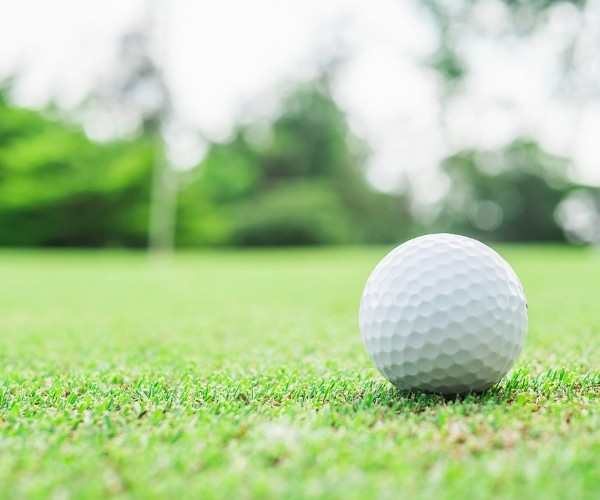- Turf
- Artificial
- Soil
- Timber
- Composite Decking
- Paving & Stone
Get In Touch With Our Experts Today!
Give us a Call! - Seed & Fertiliser
- Dressing
- Bark

October 16, 2023 Product Spotlight
One of the biggest influences on a golfer’s performance comes down to the grass they’re playing on. Not only does the cut of the grass help indicate the route of each hole, but the golf turf’s length, texture and condition can make all the difference between you scoring par, a birdie or nothing at all.
Here at Geroge Davies Turf, we’ve teamed up with some of the most prestigious golf clubs in the UK and understand the specific turf requirements for various soils and climates of each course. Along with achieving award-winning aesthetics, golfers travel worldwide to experience. But no matter the size of your golf course, the same amount of care and maintenance goes on behind the scenes.
For curious golf fans or golf club owners looking to improve the appearance and condition of their golf grass, we’ve pulled together the best golf grass seeds and greens turf for the job.
Golf grass can be split into four primary areas of play: your tee shot, the fairway, the rough and the putting green. How you look after your turf: its height, hydration, or surface level can seriously affect your shot’s roll, pace and landing, as well as impact your temperament as you play!
To determine the distinction between these areas and help guide players, golf courses use various types of grass seed to achieve contrasting textures. Alternatively, they use the same golf turf but manage each area differently to achieve its purpose. If neglected, you can be left with dry putting greens, uneven fairways and, ultimately, a disappointing game of golf for your members and guests. So yes, golf turf plays a pretty significant part.
Most golf clubs opt for a natural course, choosing between four popular grass seeds to achieve a flawless finish:
Bent grass seed typically produces a short grass blade with a thick structure. This creates a flat, even and smooth surface ideal for fairways. It’s hardwearing and can withstand a close mow for that manicured cut. However, it does require a lot of maintenance and struggles in high temperatures, meaning it needs to be watered regularly to get that visually pleasing green shade.
There are a variety of fescue seeds, making them a very versatile grass seed. They’re known for high shade tolerance, ideal for golf courses with shadowed areas from trees or nearby structures. Fescue is generally easy to maintain and can be grown to suit your golf course needs – handling close cuts for tee greens and fairways or left to grow, creating out-of-bound sections and areas of rough grass.
If you’re looking for stunning scenery and a healthy appearance for your golf course, ryegrass is a popular choice. Its rigid growth and fine texture provide a lovely surface for tees and fairways. However, it can be quite delicate and requires a fair bit of care and attention, especially in warm weather, where it will struggle if mowed too short.
A popular choice for golf clubs, Bermuda grass seed keeps your golf course looking green and healthy even during peak season. Bermuda is a golf grass option that withstands high footfall, extreme heat and drought, as well as quick regrowth and recovery. All in all, it makes an excellent turf for all areas of your golf course.
We know the importance of producing suitable turf for your golf course. That’s why we’ve worked with expert turf farmers to create our high-quality greens turf. With a combination of fescue and bent grass seed, our golf turf delivers consistently throughout the year. Its fine texture and close-mown sward create the perfect base for putting and beautiful fairways.
Although not a traditional choice for golf courses, artificial golf grass is beginning to make a small appearance. We can see some benefits, such as durability, weather resistance, consistent appearance and minimal maintenance. However, it can cost a lot upfront to install and reduce a golf club’s conservation and environmental efforts by limiting natural habitats for wildlife.
Pros and amateurs are guilty of causing divots in your perfectly mowed golf course. This often occurs on the fairway, as the golfer takes his swing and accidentally hits the grass rather than the ball, resulting in the club digging out a clump of turf.
Many golfers place the heap of turf back into the divot and hope it’ll sort itself out, which often isn’t the case. If not dealt with correctly, you can under or overfill the divot and experience an uneven surface as the grass grows back. To fix a divot, fill the hole with sand and grass seed mix, level it out and water. If you can, corner off the area until regrowth has been established.
We have the expertise and resources to deliver fresh, high-quality greens turf directly where you need it, whether on the first tee or the 18th putting green. Not only can we assist with golf turf maintenance, but our trusted relationships with turf farmers mean we can ensure you have high-quality turf ready to be laid for your prime golfing season. Speak to the George Davies team today to learn more about our premium golf turf.
CALL US NOW ON 01234 818 253